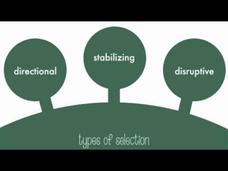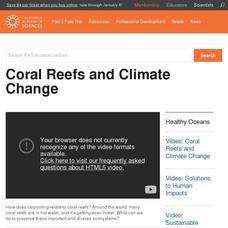California Academy of Science
What is the Environmental Impact of Feeding the World?
One in every seven people suffer from a lack of basic food. Our Hungry Planet introduces this complex issue in the second lesson of an interesting 13-part unit. It discusses the space needed to grow and raise food, the transportation of...
Curated OER
Biotic and Abiotic Factors
Life is complex. Just a slight change in the population of one species will have a substantial change on the biotic and abiotic factors of that species' environment. In this video, Mr. Andersen explains the effects removing wolves from...
Curated OER
Biodiversity
Jaguars feed on 87 different species, making it a keystone species. What happens when such a critical link of the food chain goes missing? Mr. Andersen identifies different keystone species according to ecosystem, and he explains the...
SciShow
How Studying Venus Saved Earth
Scientists discovered a hole in the ozone layer in 1980, and by 2000, the hole was three times the size of the United States. Through global efforts, scientists discovered the cause and worked together to get countries to implement a...
Teacher's Pet
Types of Natural Selection
Natural selection—good things come to those who mate. The video introduces the idea of natural selection. Then it details three types: directional, stabilizing, and disruptive. It includes both graphs and examples for each type.
Be Smart
How Many Species Are There?
Scientists discover over 15,000 new species each year. Despite studying life on our planet for all of human history, we still don't know how many species exist on Earth. An informative video from a biology playlist presents the dilemma,...
Veritasium
13 Misconceptions About Global Warming
With so much information floating around about global warming, how can we tell what's really going on? Examine the evidence through a video from Veritasium to sift through everything we hear. The narrator presents convincing data when...
Be Smart
Why I'm Scared of Spiders
Eighty-four percent of people have an irrational fear. This video focuses on a fear of spiders. It explains the different types of fear, the conditioning that creates fear, and the evolutionary advantage to these fears. It doesn't just...
PBS
That Time Oxygen Almost Killed Everything
Oxygen keeps us alive, but did you ever consider how Earth found the right balance? Eons produced this video as part of a larger series that explores when Earth contained very little oxygen and green oceans ruled the planet. Viewers see...
California Academy of Science
Bugs for Breakfast
More people in the world eat bugs as a source of protein than the number of people who don't eat bugs. Viewers consider bugs as a food source to solve multiple issues. Our Hungry Planet introduces bug-based food as a possible solution to...
Be Smart
Is Height All in Our Genes?
Humans on average are shorter than they were centuries ago. Young scholars analyze the factors that affect the height of individuals including historical trends in a video lesson. The presentation analyzes both genetic and...
California Academy of Science
Your Digital Footprint: Data and Energy Use
Understanding energy usage requires knowing more than how much energy it takes to charge your cell phone. Scholars learn each text sent uses energy as does each video, game, and phone call. They observe the larger grid of data transfers...
California Academy of Science
Coral Reefs and Climate Change
Coral reefs cover less than one percent of the ocean floor, yet more than 25 percent of marine life lives in coral reefs. A colorful, engaging video describes the health of coral reefs and why the formations matter. The first lesson in a...












